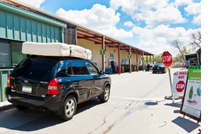How Your Refrigerator Affects the Planet . . . and How Eco-Cycle Can Help!

Remember the headlines years ago about the ozone layer crisis? Scientists identified that the hole in the ozone was primarily caused by chlorofluorocarbons (CFCs), a group of chemicals commonly found in Freon appliances like refrigerators, freezers, air conditioners, and dehumidifiers.
The global response to this crisis was fortunately swift. Thanks to the Montreal Protocol, an international treaty signed in 1987 by every country on the planet, we have restricted the production of nearly 100 ozone-depleting substances, including CFCs, so effectively that the atmosphere is healing the damage done to the ozone layer—but recovering used refrigerants is still essential.
That’s where the Eco-Cycle/City of Boulder Center for Hard-to-Recycle Materials (CHaRM) comes in. Since 2001, it has been a vital resource for recycling unusual items safely and efficiently to protect both the environment and public health.
Eco-Cycle’s CHaRM Facility Takes on Refrigerant Recycling
When refrigerators, freezers, air-conditioning units, and dehumidifiers are functioning normally, they are not posing much environmental risk. But when they malfunction or die, it’s important not to chuck them in the landfill and to take them, instead, to a recycler like the Eco-Cycle CHaRM.
In the ever-evolving recycling industry, downstream recycling markets (especially for hard-to-recycle materials) can come and go, and the Eco-Cycle CHaRM has faced repeated challenges with disappearing markets for Freon recovery. When the local option for refrigerant processing fell through earlier this year, our operations team was faced with a dilemma—how to continue offering this vital service to the community without a reliable partner to handle the complex and accredited process of Freon removal.
Rather than abandoning the service, Eco-Cycle brought refrigerant-recovery operations in-house. This decision wasn’t made lightly. It required training and professional certification of CHaRM staff to safely extract refrigerants from appliances dropped off at the facility. The process also demanded significant adjustments to the center’s operations, including additional labor and the necessity of raising the fees for Freon appliance drop-offs to cover these new costs.
As CHaRM navigated these hurdles, the steady stream of refrigerant-containing appliances arriving at the facility showed no signs of slowing. At times, the sheer volume of appliances pushed the center’s storage capacity to its limits. However, through the dedication of our warehouse operations team, we established a system that maximizes labor efficiency while safely recovering both refrigerant chemicals and the scrap metal from dozens of Freon appliances each week.
Thanks to these efforts, CHaRM not only continues to serve the local community in Boulder County and beyond, but also contributes to a larger environmental mission—keeping harmful refrigerants out of the environment and valuable materials out of the landfill.
Learn more about our Freon appliance recycling processes, and the top three best practices for recycling your Freon appliances at the Eco-Cycle CHaRM, in this video starring our two certified-expert staff members, Finn and Avery!
Understanding Freon: The Legacy and Impact of a Once-Revolutionary Refrigerant
Freon, a brand name now synonymous with chemical refrigerants, was initially developed as a safer alternative to the highly toxic substances used in early refrigeration systems. The Freon trademark includes a range of chemical compounds found in modern cooling units, from refrigerators to air conditioners.
One of the most notorious refrigerants in the Freon family is R-12, once hailed as an industry standard. But its environmental impact—specifically its role in depleting the ozone layer—led to its inclusion in the Montreal Protocol, the landmark 1987 treaty that enacted bans on the further production of many ozone-depleting substances. Despite the phase-outs, these chemicals still linger in older appliances, many of which find their way to the CHaRM in Boulder, where they’re safely recovered for reuse.
Refrigerants come in various types, each with a different Global Warming Potential (GWP). Read on to see them ranked from bad to better!
- R-12—This refrigerant is the worst that we tend to see, and is ozone-depleting. The Montreal Protocol outlawed new production of this refrigerant as of 1996, but when safely recovered from existing appliances, it can legally be put back into units that are only able to use this type. Global Warming Potential: 10,800 times as harmful for the atmosphere as CO2
- R-22—This refrigerant, common to air-conditioning units and dehumidifiers, is also ozone-depleting. GWP: 5,310 times as harmful as CO2
- R-410a—Common to ACs and dehumidifiers. In 2025, the EPA will ban this refrigerant from inclusion in new units. GWP: 4,260 times as harmful as CO2
- R-134a—These units are the most common type we get at the Eco-Cycle CHaRM, but that may change when in 2025, the EPA also bans R-134a from inclusion in new units. Studies show that this type of refrigerant poses health risks to those who come in contact with it. GWP: 3,810 times as harmful as CO2
- R-32—This is what most new air conditioners and dehumidifiers use today and is an improvement on past refrigerants. GWP: 2,530 times as harmful as CO2
- R-600a—This is what most new fridges use these days, and is the most environmentally friendly refrigerant, as it is more or less equivalent to CO2 and poses the smallest risk to the atmosphere. Draining should still be conducted by a professional, as the gas is highly flammable.
Find the full list of materials accepted for recycling at the Eco-Cycle CHaRM at ecocycle.org/what-we-accept!



























